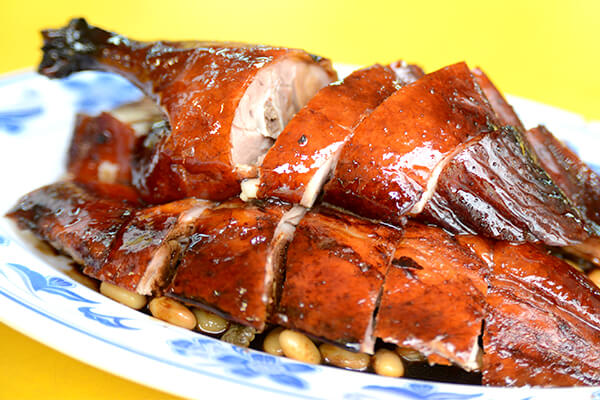Toh Kee Roast Duck
by Qian Leung
@ 30 Jun 2017

Toh Kee has been around since 1926. Prior to that, in 1918, the boss of the current roast masterchef Wong, used to carry the roast ducks on poles and sell them in Chinatown vicinity. We see a row of ducks being hung to air-dry in Chef Wong’s stall, next to the rice cooker and stove. Prior to this, the ducks had been marinated with garlic, spring onions, salt, and five-spice powder for one and a half hours.
“How long does it take for it to dry?” Dr Tay asks. “It depends,” says Chef Wong. “You have to touch it to tell if it is dry. Sometimes, when we are using the stove and the air is hot, the ducks will dry in an hour or so.” A brush of malt syrup goes onto the duck’s skin. “The malt syrup is what gives the duck’s skin that crispiness, when you roast it,” Chef Wong explains.
The duck’s necks are twisted before they are lowered into the hot brick oven. “I always wondered why they twist the duck’s necks up like that,” James ponders aloud. Chef Wong explains, “This is so that when you put it into the hot brick oven, the charcoal fires won’t catch the duck.” Every five to ten minutes, he has to check on the ducks. If any part of the duck is not colouring properly, he would need to turn them around, all the while gauging the strength of the charcoal fire.
What is interesting about the roast duck here is that they are served on cooked soyabeans. “Last time, we used to put the roast ducks on cucumbers when customers asked to have them for take-away,” Chef Wong says. “But we notice that the moisture from the cucumbers takes away the crispiness.” So they have changed to using soybeans, which requires five hours of simmering. The roast duck is also served with a black gravy of premium dark soy sauce, gold grass dust, five-spice powder, and fermented beancurd, which adds an addictive umami taste to the dish.
 Toh Kee has been around since 1926. Prior to that, in 1918, the boss of the current roast masterchef Wong, used to carry the roast ducks on poles and sell them in Chinatown vicinity. We see a row of ducks being hung to air-dry in Chef Wong’s stall, next to the rice cooker and stove. Prior to this, the ducks had been marinated with garlic, spring onions, salt, and five-spice powder for one and a half hours.
Toh Kee has been around since 1926. Prior to that, in 1918, the boss of the current roast masterchef Wong, used to carry the roast ducks on poles and sell them in Chinatown vicinity. We see a row of ducks being hung to air-dry in Chef Wong’s stall, next to the rice cooker and stove. Prior to this, the ducks had been marinated with garlic, spring onions, salt, and five-spice powder for one and a half hours.